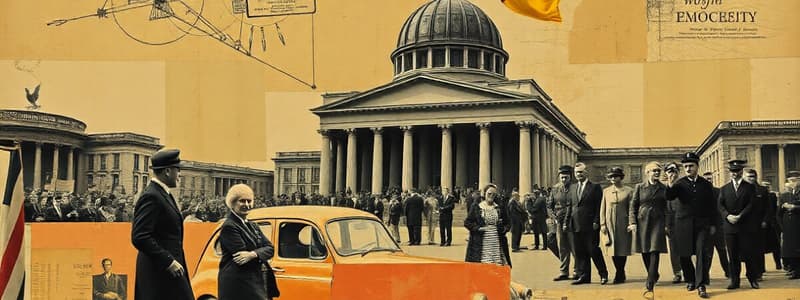Podcast
Questions and Answers
Which of the following factors contributed significantly to the instability of the Weimar Republic in its early years?
Which of the following factors contributed significantly to the instability of the Weimar Republic in its early years?
- The lack of any revolutionary sentiment following World War I.
- A strong and unified political front that quickly addressed post-war challenges.
- The 'stab in the back' myth and resentment over the Treaty of Versailles. (correct)
- Widespread support for the Weimar Constitution among all segments of German society.
How did proportional representation, as used in the Weimar Republic, impact the political landscape?
How did proportional representation, as used in the Weimar Republic, impact the political landscape?
- It led to frequent coalition governments and political instability. (correct)
- It ensured stable, majority governments.
- It reduced the influence of smaller political parties.
- It strengthened the power of the President, allowing for quicker decision-making.
What was the significance of Article 48 in the Weimar Constitution?
What was the significance of Article 48 in the Weimar Constitution?
- It established the process for electing the President.
- It allowed the President to rule by decree in times of emergency. (correct)
- It outlined the powers of the Reichstag.
- It guaranteed freedom of speech and assembly.
How did the invasion of the Ruhr by France and Belgium in 1923 exacerbate Germany's economic crisis?
How did the invasion of the Ruhr by France and Belgium in 1923 exacerbate Germany's economic crisis?
What was the primary goal of the Dawes Plan?
What was the primary goal of the Dawes Plan?
Which of the following best describes the impact of hyperinflation on the German population?
Which of the following best describes the impact of hyperinflation on the German population?
How did Gustav Stresemann contribute to the recovery of the Weimar Republic?
How did Gustav Stresemann contribute to the recovery of the Weimar Republic?
What was the Locarno Treaty, and why was it significant for Germany?
What was the Locarno Treaty, and why was it significant for Germany?
Which of the following is an accurate description of the political spectrum during the Weimar Republic?
Which of the following is an accurate description of the political spectrum during the Weimar Republic?
What role did the Freikorps play in the early years of the Weimar Republic?
What role did the Freikorps play in the early years of the Weimar Republic?
What was the Kellogg-Briand Pact, and what did it signify for Germany?
What was the Kellogg-Briand Pact, and what did it signify for Germany?
How did the Weimar Constitution address the issue of equality?
How did the Weimar Constitution address the issue of equality?
What was the primary focus of the 'New Objectivity' (Neue Sachlichkeit) movement in Weimar Germany?
What was the primary focus of the 'New Objectivity' (Neue Sachlichkeit) movement in Weimar Germany?
Which of the following factors best explains the initial economic hardship faced by Germany immediately after World War I?
Which of the following factors best explains the initial economic hardship faced by Germany immediately after World War I?
How effective was the Weimar Republic in reducing homelessness by 1928?
How effective was the Weimar Republic in reducing homelessness by 1928?
Which art and design movement, characterized by its use of bold designs and unusual materials, emerged during the Weimar Republic?
Which art and design movement, characterized by its use of bold designs and unusual materials, emerged during the Weimar Republic?
What was a significant change women experienced during the Weimar Republic?
What was a significant change women experienced during the Weimar Republic?
What was a key aspect of the new operas and plays that emerged during the Weimar Republic?
What was a key aspect of the new operas and plays that emerged during the Weimar Republic?
How did the economic reliance on American loans impact Germany's long-term stability during the Weimar Republic?
How did the economic reliance on American loans impact Germany's long-term stability during the Weimar Republic?
Which statement best describes the view of the middle class towards the Weimar Republic during the hyperinflation crisis?
Which statement best describes the view of the middle class towards the Weimar Republic during the hyperinflation crisis?
Flashcards
Armistice
Armistice
Agreement to stop fighting, Germany asked for it in 1918.
November Criminals
November Criminals
Weimar politicians blamed for the 'Stab in the Back' of Germany by surrendering at the end of World War One.
Constitution
Constitution
The system of laws and rules of a country.
Article 48
Article 48
Signup and view all the flashcards
Chancellor
Chancellor
Signup and view all the flashcards
President
President
Signup and view all the flashcards
Coalition
Coalition
Signup and view all the flashcards
Extremist
Extremist
Signup and view all the flashcards
Communism
Communism
Signup and view all the flashcards
Fascists
Fascists
Signup and view all the flashcards
Freikorps
Freikorps
Signup and view all the flashcards
Spartacists
Spartacists
Signup and view all the flashcards
Putsch
Putsch
Signup and view all the flashcards
Reparations
Reparations
Signup and view all the flashcards
Article 231
Article 231
Signup and view all the flashcards
Kaiser Wilhem II
Kaiser Wilhem II
Signup and view all the flashcards
Inflation
Inflation
Signup and view all the flashcards
Treaty of Versailles Terms
Treaty of Versailles Terms
Signup and view all the flashcards
Article 231
Article 231
Signup and view all the flashcards
Study Notes
Setting up the Weimar Republic
- Kaiser II abdicated and fled Germany on November 9, 1918
- The Weimar Republic was established on November 9, 1918
- Friedrich Ebert of the Social Democrat party (SPD) became Chancellor of the new government on November 10, 1918
- Germany became a democracy for the first time
The Weimar Constitution
- Established after World War I, it aimed to create a fair democratic government
- It had strengths like proportional representation, ensuring small parties had a voice
- Guaranteed freedom of speech and religion
- All genders over 20 could vote
- The Reichstag was elected by the people and made the laws
- Weaknesses included coalition governments
- Army, judges and civil servants wanted a return of the Kaiser
- Article 48 allowed the President to take control in an emergency, leading to dictatorship
Treaty of Versailles
- Signed on June 28, 1919, it was decided by Britain, France, and the United States
- Germany had no say in the terms
- Limited Germany to 100,000 soldiers, banned conscription, tanks, and artillery
- Navy restricted to 6 battleships, submarines forbidden
- German air force banned
- Rhineland demilitarized
- Germany had to accept full responsibility via Article 231
- Germany was not allowed to join the League of Nations
- They had to pay £6.6 billion in reparations
- France was given the Saar coalfields for 15 years
- Lost 13% of its land and 6 million Germans, overseas Empire, territories to Poland
- Germans called it the 'Diktat', blaming Ebert and government as "November Criminals"
Early Challenges: Threats from the Left & Right
- From 1918-1923, the Weimar Republic faced threats from both left and right-wing groups
Threats from the Left-Wing
- Spartacists: Extreme leftists led by Karl Liebknecht and Rosa Luxemburg
- Aimed to turn Germany into a communist country
- 50,000 Spartacists attempted to overthrow Ebert
- Seized government newspapers but failed to gain widespread support
- The army and Freikorps suppressed the uprising
Threats from the Right-Wing
- Extreme right-wing groups wanted a strong military leadership
- Objected to the Treaty of Versailles
- Kapp Putsch: Led by Wolfgang Kapp in 1920 with Freikorps support
- Took over government buildings, declared a new right-wing government
- Weimar government fled and ordered army to stop the putsch, but was refused
The Crises of 1923
- Germany was struggling to pay £6.6 billion in reparations due to The Treaty of Versailles
- France and Belgium needed money to pay off their war debts to USA so decided to take raw materials like coal and steel for themselves by going into the Ruhr
- The workers went on strike refusing to work, some even burned factories
- The French then shoot a number of strikers and some French soldiers are also killed.
- This led to the second crisis of hyperinflation!
Hyperinflation Crisis of 1923
- It was caused by reparations (£6.6 billions) and the occupation of the Ruhr
- Government printed more money, leading to a loss of value of the money but prices went up
- Workers did well as they were paid higher wages
- Middle classes savings were made worthless by inflation
Recovery Under Stresemann (1924-1929)
- Gustav Stresemann became Chancellor in August 1923
- He tacked hyperinflation, Ruhr crisis, and international standing.
Actions
- Introduced Rentenmark
- US banker Charles Dawes created The Dawes Plan which ordered all old currency to be burned
- The Dawes Plan set annual payments and US banks loaned money to Germany
- The Young Plan reduced reparation payments from £6 billion to $1.85 billion to be paid over 60 years
- Stresemann ended the strike in Ruhr which led to France and Belgium to pull out their troops
- Signed Locarno Treaty with France, Belgium, Great Britain, and Italy in 1925.
- Improved international relations and Germany was allowed to join the League of Nations in 1925
Weimar Golden Age
- Wages increased and German workers were among the best-paid in Europe by 1928
- The government built over two million new homes
- Unemployment insurance law in 1927
- Women over 20 were given the vote and freedom socially
- Bauhaus with bold designs, unusual materials with basic colours and cinema became popular
Studying That Suits You
Use AI to generate personalized quizzes and flashcards to suit your learning preferences.



